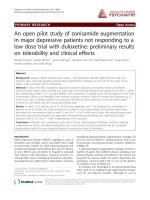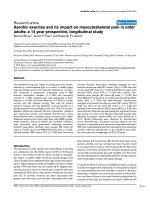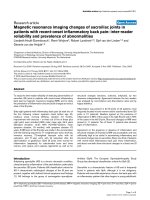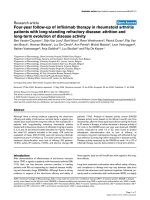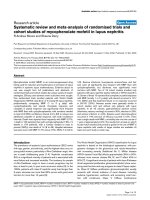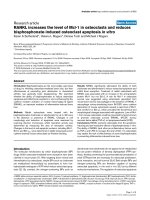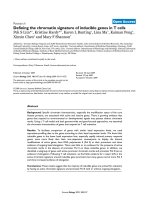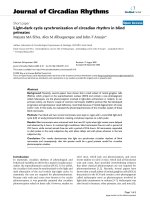Báo cáo y học: "Systematic review and meta-analysis of randomised trials and cohort studies of mycophenolate mofetil in lupus nephritis" pdf
Bạn đang xem bản rút gọn của tài liệu. Xem và tải ngay bản đầy đủ của tài liệu tại đây (387.59 KB, 10 trang )
Open Access
Available online />Page 1 of 10
(page number not for citation purposes)
Vol 8 No 6
Research article
Systematic review and meta-analysis of randomised trials and
cohort studies of mycophenolate mofetil in lupus nephritis
R Andrew Moore and Sheena Derry
Pain Research and Nuffield Department of Anaesthetics, University of Oxford, The Churchill, Headington, Oxford OX3 7LJ, UK
Corresponding author: R Andrew Moore,
Received: 14 Aug 2006 Revisions requested: 19 Sep 2006 Revisions received: 23 Oct 2006 Accepted: 12 Dec 2006 Published: 12 Dec 2006
Arthritis Research & Therapy 2006, 8:R182 (doi:10.1186/ar2093)
This article is online at: />© 2006 Moore and Derry; licensee BioMed Central Ltd.
This is an open access article distributed under the terms of the Creative Commons Attribution License ( />),
which permits unrestricted use, distribution, and reproduction in any medium, provided the original work is properly cited.
Abstract
Mycophenolate mofetil (MMF) is an immunosuppressant drug
being used for induction and maintenance of remission of lupus
nephritis in systemic lupus erythematosus. Evidence about its
use was sought from full publications and abstracts of
randomised trials and cohort studies by using a variety of search
strategies. Efficacy and adverse event outcomes were sought.
Five randomised trials enrolled patients with World Health
Organization (WHO) class III, IV, or V (mostly IV) lupus nephritis,
predominantly comparing MMF (1 to 3 g daily) with
cyclophosphamide and steroid. Complete response and
complete or partial response was significantly more frequent
with MMF than with cyclophosphamide, with numbers needed
to treat of 8 (95% confidence interval 4.3 to 60) to induce one
additional complete or partial response, with wide confidence
intervals. Death was reported less frequently with MMF (0.7%,
1 death in 152 patients) than with cyclophosphamide (7.8%, 12
deaths in 154 patients), with a number needed to treat to
prevent (NNTp) one death of 14 (8 to 48). Hospital admission
was also lower with MMF (1.7% versus 15%; NNTp 7.4 [4.8 to
16]). Serious infections, leucopaenia, amenorrhoea, and hair
loss were all significantly less frequent with MMF than with
cyclophosphamide, but diarrhoea was significantly more
common with MMF. Ten of 18 cohort studies enrolled only
patients with lupus nephritis (author-defined or WHO class III to
V). Seven of these 10 reported that complete or partial response
with MMF (mostly 1 or 2 g daily) with steroid occurred in 121/
151 (80%) and that treatment failure or no response occurred
in 30/151 (20%). Adverse events were generally similar in
cohort studies with and without only patients with lupus
nephritis. In all 18 cohorts, gastrointestinal adverse events
(diarrhoea, nausea, vomiting) occurred in 30%, infection in 23%,
and serious infection in 4.3%. Adverse event discontinuations
occurred in 14% and lack of efficacy occurred in 10%. There
was a single death with MMF, a mortality rate over the course of
1 year of approximately 0.2%. The results form a basis on which
to plan future studies and provide a guide for the use of MMF in
lupus nephritis until results of larger studies are available. At
least one such study is under way.
Introduction
The prevalence of systemic lupus erythematosus (SLE) varies
with age, gender, and ethnicity, and the highest rates occur in
young adult women, particularly of Afro-Caribbean origin, who
are in peak childbearing years [1-4]. Nephritis complicates
SLE in a significant minority of patients and is associated with
renal failure and increased mortality. The tendency for people
of Afro-Caribbean origin to have a worse prognosis may be
due, at least in part, to poor socio-economic status [5]. In the
1950s, patients with class IV nephritis rarely lived longer than
5 years, whereas now more than 80% survive with good renal
function for more than 10 years [6].
The World Health Organization (WHO) classification for lupus
nephritis is based on the histological appearance, with pro-
gressive changes to the glomerulus and tubulo-interstitium
with increasing severity (Additional file 1). Milder disease
(WHO classes II and IIIa) affects approximately 35% to 50%,
whereas more serious classes IIIb, IV, and V affect 45% to
60% [7]. A significant minority of patients with class III disease
(focal segmental proliferative glomerulonephritis) show wors-
ening renal function and may progress to class IV lupus nephri-
tis. Class IV (diffuse proliferative glomerulonephritis) usually
presents with clinical evidence of renal disease, including
oedema, hypertension, sediment, and worsening renal func-
tion with proteinuria. Class V (diffuse membranous
MMF = mycophenolate mofetil; NNH = number needed to harm; NNT = number needed to treat; NNTp = number needed to treat to prevent one
event; SLE = systemic lupus erythematosus; WHO = World Health Organization.
Arthritis Research & Therapy Vol 8 No 6 Moore and Derry
Page 2 of 10
(page number not for citation purposes)
glomerulonephritis) involves patients with laboratory and clini-
cal features of nephrotic syndrome.
The aim of treatment is first to stop disease progression
(induction phase) and then prevent recurrence (maintenance)
while minimising the adverse effects. More specifically with
lupus nephritis, the aims of treatment are to reduce the risk of
end-stage renal disease, reduce renal and extra-renal lupus
activity or symptoms, and reduce the mortality risk.
Treatment with immunosuppressive therapy is better than
prednisolone monotherapy at preserving renal function, and
combination therapy is better still [8-10]. Cyclophosphamide
is used mainly to induce remission in patients with proliferative
disease and has been considered to produce the best renal
outcomes [11]. A systematic review of immunosuppressive
treatments for lupus nephritis highlighted some of the prob-
lems [10]. These included ovarian failure, affecting 47% of
women treated with cyclophosphamide plus steroid, and
major infection in 20%. Nor were therapies entirely effective
using cyclophosphamide plus steroid; doubled serum creati-
nine was observed in 24%, end-stage renal disease in 16%,
and mortality in 21%. Weaknesses of these estimates
included small numbers of trials and patients (maximum 290 in
comparisons with steroid alone) and pooling data from
patients with different disease severity who were being admin-
istered different regimens of immunosuppressive therapy. Few
mentioned any blinding, but this is more difficult in long-term
comparisons of parenteral and oral therapies.
Mycophenolate mofetil (MMF) is a relatively well-tolerated
immunosuppressive agent used after kidney, liver, and heart
transplants. MMF selectively and noncompetitively inhibits ino-
sine monophosphate dehydrogenase in the de novo purine
synthesis pathway. This enzyme facilitates the conversion of
inosine monophosphate to xanthine monophosphate, an inter-
mediate metabolite in the production of guanosine triphos-
phate. Because MMF results in the depletion of guanosine
nucleotides, it impairs RNA, DNA, and protein synthesis [12].
Pharmacokinetics and metabolism of MMF suffer no major
perturbations in renal impairment [13], but this may not be the
case for severe renal insufficiency.
One year after renal transplantation, MMF at 2 or 3 g daily was
at least as effective as azathioprine regimens at maintaining
graft survival. Patient survival was similar, with a tendency to
higher survival rates at longer duration [14,15]. MMF may be
particularly beneficial in African-Americans [16]. MMF has also
been shown to have some benefits over calcineurin inhibitors
after liver transplantation [17]. MMF reduced mortality and
graft loss compared with azathioprine over three years after
heart transplantation in a large randomised trial [18]. Adverse
events with MMF have tended to be different from those of
other commonly used immunosuppressants. Diarrhoea may be
more common [15,18] whereas ovarian failure is less common
with MMF than with cyclophosphamide. The aim of this review
was to systematically examine the available evidence concern-
ing MMF in lupus nephritis from randomised trials and obser-
vational studies.
Materials and methods
QUOROM (quality of reporting of meta-analyses) and
MOOSE (meta-analysis of observational studies in epidemiol-
ogy) guidelines were followed where applicable [19,20]. Stud-
ies of any design and in any language were sought concerning
MMF in the treatment of patients with complications of lupus
nephritis or SLE. A series of free text searches were under-
taken to identify eligible reports from MEDLINE (to September
2005), Cochrane Library (Issue 3, 2005), and PubMed (to
October 2006) by using the terms MMF or mycophenolate
and the terms lupus nephritis or lupus erythematosus. Addi-
tional trials were sought in review articles [9,10,21-29] and
reference lists of retrieved articles. The company (Aspreva
Pharmaceuticals Ltd, Bagshot, Surrey, UK) developing Cell-
Cept for lupus nephritis was asked about the availability or
knowledge of published or unpublished clinical trials. Authors
of papers were not contacted for unpublished reports or addi-
tional information from published reports.
For completeness, we included studies in three separate
groups: randomised trials, cohort studies with patients with
SLE and lupus nephritis, and cohort studies with patients with
SLE, only some of whom had lupus nephritis or undefined
renal involvement. Full publications and abstracts were
allowed. With multiple publications of the same study, we
used the largest body of data or the most informative or the
most recent (as appropriate). Excluded were reviews with clin-
ical information published in a fuller form elsewhere, studies
with purely biochemical (biomarker), pharmacokinetic, or
immunological information, and studies in which MMF was
used for treating other conditions.
Each randomised trial was scored for quality by using a three-
item quality scale [30]. A maximum of five points were
awarded to studies according to whether they were ran-
domised, double-blind, and accounted for withdrawals or
drop-outs and to whether the methods of randomisation and
double-blinding were described and appropriate. No scoring
system was used for cohort studies.
Two reviewers extracted information from the trials independ-
ently, and disagreement was resolved by consensus. Informa-
tion extracted included the number of patients treated (per
group in randomised trials), demographic information given
(age, gender, and ethnicity), definition or classification of lupus
nephritis (WHO was used), dosing regimens, duration of ther-
apy, information about patients studied and their diagnoses,
study design, the number of patients with efficacy and/or
safety outcomes, and discontinuations, especially because of
adverse events or lack of efficacy. Efficacy outcomes sought
Available online />Page 3 of 10
(page number not for citation purposes)
were those of complete or partial response to treatment as
defined by the original authors (mainly urine protein excretion,
serum creatinine or creatinine clearance, or a combination of
these) and subsequent relapse. Adverse events sought
included mortality, infection (especially severe infection), leu-
copaenia, gastrointestinal problems, amenorrhoea (in women),
and hospital admission because of adverse events.
For analysis of efficacy, only those studies or trials with
patients with both SLE and lupus nephritis were included. Any
definition of lupus nephritis, as provided by authors, was
accepted. If studies included patients who did not have lupus
nephritis, efficacy information was only used for analysis if
reported separately for nephritis patients. We used informa-
tion on all patients for evaluation of adverse events because
there was no prior indication that adverse events would be dif-
ferent in patients with SLE with or without nephritis or with dif-
ferent grades of nephritis.
For cohort studies, we calculated the percentage of patients
with beneficial or harmful events by using as the denominator
the total number of patients in studies mentioning the event.
For randomised trials in which MMF was compared with
another treatment, relative benefit and relative risk estimates
were calculated with 95% confidence intervals by using a
fixed effects model [31]. Because they have previously been
shown to be unhelpful, heterogeneity tests were not used
[32]; homogeneity was assessed visually [33]. Publication
bias was not assessed using funnel plots, likewise because
these tests have been shown to be unhelpful [34,35]. Relative
benefit or risk was considered statistically significant when the
95% confidence interval did not include 1. The number
needed to treat (NNT) and number needed to harm (NNH)
with confidence intervals were calculated by the method of
Cook and Sackett [36]. NNT or NNH values were calculated
only when the relative risk or benefit was statistically
significant.
The following terms were used to describe adverse outcomes
with respect to harm or prevention of harm:
• The NNT to prevent one event (NNTp). We used this term
when significantly fewer adverse events occurred with MMF
than with the comparator.
• The NNH to cause one event. We used this term when sig-
nificantly more adverse events occurred with MMF than with
the comparator.
Results
Additional file 2 has details of all the relevant studies found;
there were no exclusions after screening, but not all studies
were used in analyses. Six randomised trials in eight papers
[37-44] reported on 370 patients in total, 197 of whom were
treated with MMF. Ten cohort studies [45-54] reported on the
use of MMF in 212 patients with lupus nephritis, and 8 cohort
studies [55-62] reported on 284 patients with SLE treated
with MMF, only some of whom had nephritis or renal problems.
For several studies, there were multiple reports; duplicate
information was avoided through detailed attention to authors,
place of research, design, and study numbers. No study
reported results separately for different classes of lupus
nephritis or by ethnicity. Ethnicity was inconsistently reported
(Additional file 2).
Randomised trials
Two trials [37,38] were available as abstracts; one had [37] no
useful data and was not included in any analysis. Two reports
[41,42] refer to a 12-month trial using MMF followed by a
switch to azathioprine [41], to which an extension with
amended protocol with continued use of MMF was added
[42]. It was not possible to separate results of the extension to
the earlier trial, and for the purposes of data extraction, we
used the later report, which included more patients [42].
The five studies used for analysis had quality scores of 2/5
(one trial) or 3/5 (four trials). They involved patients with SLE
and lupus nephritis and used recognised diagnostic criteria for
SLE and patients with biopsy-proven nephritis. Of the ran-
domly assigned patients, 38 had WHO class III disease, 241
class IV, 27 class V, and 15 mixed membranoproliferative.
Patients in the trials were predominantly (89%) women with
average ages in the early or mid-30s. Information on ethnicity
in four trials either was given or could be assumed from the ori-
gin of the study; of 306 patients, 27 were white, 106 black, 58
Hispanic, and 115 other, predominantly oriental.
Doses of MMF were in the range of 1 to 3 g daily, and doses
were adjusted according to response and tolerability. Some
trials reduced doses for maintenance therapy when remission
was achieved, whereas in two [55,56], the mean daily doses
were 2.7 and 1.6 g, respectively, without tailing. Corticoster-
oids were usually given together with MMF and comparators,
usually with adjusted, tailing doses. Cyclophosphamide was
the comparator in 199 of 218 patients and was given intrave-
nously in 167 of 199 patients; azathioprine was used in 19
patients.
Two trials compared MMF and cyclophosphamide for induc-
tion treatment over the course of 6 to 9 months [43,44]. Two
more [38,42] made the same comparison for induction fol-
lowed by maintenance for up to 84 and 12 months, respec-
tively, whereas a fifth [37] had tailing doses of MMF and
appeared to involve both induction and maintenance. Only one
trial [39] was clearly a maintenance regimen of MMF in a com-
parison with both cyclophosphamide and azathioprine, but
with only 20 patients in each group.
Arthritis Research & Therapy Vol 8 No 6 Moore and Derry
Page 4 of 10
(page number not for citation purposes)
Cohorts
Eleven of the 18 cohort studies were available as full publica-
tions, and the other seven were available only as abstracts.
Thirteen of the cohorts were prospective, four retrospective,
and one [49] unclear. Patients in the 18 cohorts were predom-
inantly (89%) women with age ranges generally from 16 to 60
years and average ages in the mid-30s. All described patients
with SLE, predominantly fulfilling acknowledged diagnostic
criteria, were inadequately controlled with corticosteroids,
cytotoxics, cyclosporine, or antimalarial drugs.
Of 18 cohorts, 10 (212 patients [45-54]) included only indi-
viduals with lupus nephritis. Documentation of nephritis used
biopsy and histology in five [50-54], but also deteriorating
renal function, rising anti-double-stranded DNA titres, or inad-
equate control on conventional immunosuppressive therapy.
Of the patients from the reports and descriptions, 14 had
WHO class III disease, 136 class IV, and 62 class V. Informa-
tion on ethnicity in eight cohorts either was given or could be
assumed from the origin of the study; of 174 patients, 42 were
white, 20 black, 1 Hispanic, and 111 other, predominantly
oriental.
Eight other cohorts [55-62] included patients with SLE, some
of whom had lupus nephritis; of 284 patients studied, 63 had
WHO classifications for lupus nephritis (1 class II, 16 class III,
35 class IV, and 11 class V). Information on ethnicity in three
cohorts either was given or could be assumed from the origin
of the study; of 161 patients, 95 were white, 46 black, and 20
other.
Doses of MMF were between 125 mg and 3 g daily, but aver-
age or median doses were generally between 1 and 2 g daily.
The duration of follow-up of patients on MMF was generally
between 6 and 36 months, and average follow-ups were gen-
erally of 1 year or longer. None of the studies clearly indicated
that they were specifically for induction or maintenance of
renal remission. Corticosteroids were usually given together
with MMF.
Efficacy
Randomised trials
Results for complete response and complete plus partial
response in induction and maintenance therapy are shown in
Table 1, in which the comparator was cyclophosphamide.
There was a consistent response between studies. Figure 1
plots the proportion of patients in each trial with a complete
and partial response with MMF or cyclophosphamide and
shows the variability between individual trials.
Table 1
Outcomes of randomised trials
Outcome Number of trials Number of
patients
Percentage with
MMF
Percentage with
cyclophosphamide
Relative benefit or
risk (95% CI)
NNT (95% CI)
Efficacy
Complete response 4 266 36 23 1.5 (1.1 to 2.1) 7.6 (4.2 to 43)
Complete or partial
response
5 306 66 54 1.2 (1.03 to 1.4) 8.0 (4.3 to 60)
Subsequent relapse 2 102 27 34 0.8 (0.4 to 1.4)
Adverse events NNTp (95% CI)
Death 5 306 0.7 7.8 0.2 (0.07 to 0.7) 14 (8 to 48)
Hospital admission 2 220 1.7 15 0.1 (0.04 to 0.5) 7.4 (4.8 to 16)
Adverse event
discontinuations
3 246 1.6 5.6 0.3 (0.08 to 1.4)
All infections 4 280 39 73 0.5 (0.4 to 0.7) 3.0 (2.3 to 4.4)
Serious infections 4 304 3.9 15 0.3 (0.1 to 0.6) 8.7 (5.5 to 21)
Leucopaenia 3 122 1.6 25 0.1 (0.03 to 0.5) 4.3 (2.9 to 8.3)
Amenorrhea 5 312 1.9 12 0.2 (0.08 to 0.6) 9.5 (6.2 to 20)
Hair loss 3 240 0.0 16 0.1 (0.01 to 0.4) 6.4 (4.4 to 11)
NNH (95% CI)
Diarrhoea 4 260 16 4.0 4.0 (1.5 to 10) 8.5 (5.3 to 21)
CI, confidence interval; MMF, mycophenolate mofetil; NNH, number needed to harm; NNT, number needed to treat; NNTp, number needed to
treat to prevent one event.
Available online />Page 5 of 10
(page number not for citation purposes)
MMF was significantly better than cyclophosphamide, with
NNTs of approximately 8 for MMF compared with cyclophos-
phamide for one additional complete or complete plus partial
response (that is, for every eight patients treated, one more
achieved a response with MMF than with cyclophosphamide).
Restricting the analysis to the four induction trials with 266
patients (omitting [41]) improved the NNT to 6.6 (95% confi-
dence interval 3.7 to 30). The proportion of patients with com-
plete or partial response in patients given MMF was 66%.
Subsequent relapse after successful induction was reported
in two trials, in 14/52 patients on MMF and 17/50 patients on
cyclophosphamide.
Cohort studies
Complete or partial response to therapy with MMF was
reported in 7 of the 10 cohort studies that recruited only
patients with lupus nephritis. Complete or partial response
was reported in 80% (Table 2) and failure or no response was
reported in 20%. All 10 studies reported some measure of
clinical or biochemical improvement. Reduced protein excre-
tion was mentioned in 10, reduced corticosteroid dose in 7,
with 3 each mentioning reduced serum creatinine and disease
severity or increased serum albumin. Where numerical data
were given, reduction in urinary protein excretion appeared to
be of a major magnitude; average reductions were often
greater than 50%, and reduction in average corticosteroid
dose was also approximately 50% or more.
Adverse events
Randomised trials
Death was reported less frequently with MMF (0.7%, 1 death
in 152 patients) than with cyclophosphamide (7.8%, 12
deaths in 154 patients), with an NNTp of 14 (Table 1) (that is,
for every 14 patients treated, 1 less death occurred with MMF
than with cyclophosphamide).
Other adverse events occurred significantly less frequently
with MMF than with cyclophosphamide, including all infec-
tions, serious infections, leucopaenia, amenorrhoea, and hair
loss, with NNTp values of 3 to 10 compared with cyclophos-
phamide. Amenorrhoea was usually absent with MMF (Table
1). The information on all infections is dominated by the largest
study [44], in which infection reporting was detailed but in
which some patients may have had more than one infection.
Diarrhoea occurred significantly more frequently (16%) with
MMF than with cyclophosphamide (4%), with an NNH of 9.
Adverse event discontinuations were not significantly different
between the two treatments.
The number of days spent in hospital was 1 per patient per
year with MMF or azathioprine in the maintenance trial [39]
compared with 10 per patient per year for cyclophosphamide.
Two induction studies [42,44] noted that the number of hos-
pital admissions (usually after a serious adverse event such as
vomiting and dehydration) was lower with MMF than with
cyclophosphamide. There were 2 admissions for 115 patients
with MMF compared with 16 admissions for 105 patients with
cyclophosphamide. This rate was significantly lower for MMF
compared with cyclophosphamide, with an NNTp of 7.
Cohort studies
Table 2 shows adverse event rates for all patients treated with
MMF in all 18 cohort studies and for the set of 10 cohorts
studies in which all patients had lupus nephritis and the set of
eight additional studies in which only some had documented
lupus nephritis or other renal problems. Adverse event rates
were broadly similar in these two sets of cohorts, given the
small number of events in some cases.
Overall, adverse event discontinuations averaged 14% and
lack of efficacy discontinuations averaged 10% in the cohort
studies (Table 1). Whereas any infection was common (23%),
serious infections affected approximately 1 patient in 25, and
approximately 1 in 30 had leucopaenia. Gastrointestinal symp-
toms of diarrhoea, nausea, and vomiting were common. Hair
loss was reported in only two studies, with 5 cases in 42
patients. Amenorrhoea was not reported.
Figure 1
Complete plus partial response to oral mycophenolate mofetil (MMF) or intravenous or oral cyclophosphamide (C)Complete plus partial response to oral mycophenolate mofetil (MMF) or
intravenous or oral cyclophosphamide (C). The blue circles show trials
with oral agents, with the sole maintenance trial using oral agents in
dark blue. The inset scale represents the overall number of patients in
each comparison.
Arthritis Research & Therapy Vol 8 No 6 Moore and Derry
Page 6 of 10
(page number not for citation purposes)
A single death occurred 1 year after a serious infection ([51];
Additional file 2). Assuming that death was an outcome likely
to be reported in any study, this is a rate of 0.2% over the
course of an average treatment period of at least 1 year.
Discussion
Meta-analysis of small studies is problematic [63] because of
possible inadequacies in design or reporting or because small
numbers of patients and events increase the risk of chance
findings [64]. The ideal is meta-analysis of high-quality, large,
randomised trials [63], but without them we have to make the
best of the information available and of all the information avail-
able. That is the justification, as here, for including information
from both randomised trials and observational studies and (for
adverse events) from observational studies in SLE in which
only a proportion had lupus nephritis. Results, as here, can be
reported separately to support any conclusions in which they
are in concordance or to raise doubts about results in which
they are not.
The background in lupus nephritis is one of few studies and
small numbers. For cyclophosphamide and azathioprine, the
mainstay of immunosuppressant therapy, there are at most
200 to 300 patients in randomised comparisons of
immunosuppressant plus steroids with steroids alone [10]. In
this analysis of MMF compared with cyclophosphamide for
induction therapy, there were 197 patients treated with MMF
in randomised trials. Ten cohort studies contributed informa-
tion from an additional 212 patients.
Randomised trials, cohorts with lupus nephritis, and cohorts
with SLE differed from each other (Table 3). Although the dis-
tribution of classes of lupus nephritis was broadly similar
between randomised trials and cohorts with lupus nephritis,
the ethic distribution was not. In randomised trials and cohort
studies, whites were in a minority; in cohorts of SLE patients,
they were in the majority. Even in randomised trials and
cohorts with lupus nephritis, there were differences, with other
race (principally oriental) predominating in cohorts with lupus
nephritis.
Despite these differences, the main findings of both ran-
domised trials and cohort studies were much the same. Com-
plete plus partial response with MMF occurred in 66% of
patients in randomised trials and in 80% in cohorts, a similar
proportion given the relatively small numbers. Mortality with
MMF in randomised trials was of the same order of magnitude
as in cohort studies (0.2%), with only two deaths. Adverse
event rates were also similar (Figure 2), but numbers of events
were small in many cases. For instance, hair loss in cohort
studies depended on only five cases in two studies.
Table 2
Outcomes of cohort studies
All cohort studies Only definite nephritis Any SLE patients
Outcome Number of
cohorts
Number of
events/patients
Percentage
with outcome
Number of
cohorts
Number of
events/patients
Percentage
with outcome
Number of
cohorts
Number of
events/patients
Percentage
with outcome
Efficacy
Complete or
partial response
7 121/151 80 7 121/151 80 No data
Failure/No
response
8 37/176 21 7 30/151 20 1 7/25 28
Adverse events
Adverse event
discontinuations
9 40/285 14 4 6/68 8.8 5 34/217 16
Lack of efficacy
discontinuations
5 24/235 10 1 4/24 17 4 20/211 9.5
All infections 10 76/327 23 4 18/70 26 6 58/257 23
Serious
infections
8 8/185 4.3 4 4/87 4.6 4 4/98 4.1
Gastrointestinal
(diarrhoea,
nausea,
vomiting)
14 122/406 30 8 52/160 33 6 58/257 29
Leucopaenia 8 6/188 3.2 4 1/61 1.6 4 5/127 3.9
Vertigo,
dizziness
3 6/81 7.4 No data 3 6/81 7.4
Hair loss 2 5/42 12 1 1/13 7.7 1 4/29 14
SLE, systemic lupus erythematosus.
Available online />Page 7 of 10
(page number not for citation purposes)
Adverse event rates in lupus nephritis patients were similar to
those in patients with SLE (Table 2) and also to those found in
renal [14,15] and heart [18] transplants. This provides addi-
tional reassurance of safety and tolerability of MMF, often at
high doses (like the 3 g daily in the heart transplant trial) and
over a treatment duration of up to 3 years. Despite this, there
is the possibility of residual bias in observational studies and
lack of blinding in randomised trials. The amount of information
for MMF is greater than for cyclophosphamide and azathio-
prine in this indication, and trials, if anything, are somewhat
better, but this is no defence against features of study design
which we know may mislead [65].
Although the analysis provides information about efficacy and
safety on average, it does not help determine which patients
will respond best to MMF or other immunosuppressants. In
most studies, either the requirement for entry was reasonable
renal function (creatinine clearance greater than 30 ml/minute
[44] or 20 ml/minute [39]) or renal function was relatively
unimpaired (mean creatinine clearance was 80 ml/minute
[43]). Patients with more severe renal disease were excluded,
so we do not have information about efficacy or harm in the
sickest patients, nor do we have much information about long-
term maintenance rather than induction therapy.
Moreover, information was not reported separately for different
racial groups or for different WHO classes of lupus nephritis,
both of which are important considerations for determining
appropriateness of therapy. Practitioners may be frustrated by
the inability of a review to provide results for subgroups or bet-
ter definitions of outcomes, but analysis can be performed only
on average results unless individual results are available. The
ideal would be an individual patient analysis based on collab-
oration between trialists.
Within these limitations, the evidence is that daily oral MMF is
more effective than pulsed intravenous or oral cyclophospha-
mide. It produced more complete responses and complete
plus partial responses, and the absolute difference, equivalent
to an NNT of 8, was clinically useful. This better efficacy came
with lower mortality, fewer hospital admissions, and lower
rates of several adverse events, including severe infection. In a
patient population of young women of childbearing age, it pro-
duced almost no cases of amenorrhoea and no cases of hair
loss in randomised trials. Evidence from renal transplantation
[66] is that MMF may also reduce cardiovascular risk relative
to other immunosuppressants, and there are some theoretical
reasons for this [67].
This is the first systematic review of MMF in lupus nephritis,
but another is under way [68]. The previous systematic review
Table 3
Differences in patients recruited to different study types
Percentage of ethnic origin
Studies Percentage with
WHO class III
Percentage with
WHO class IV
Percentage with
WHO class V
White Black Hispanic Other
Randomised trials 12 78 10 9 35 19 38
Cohort of lupus nephritis 7 64 29 24 11 1 63
Cohort of SLE Not appropriate 59 29 0 12
SLE, systemic lupus erythematosus; WHO, World Health Organization.
Figure 2
Comparison of adverse event rates with mycophenolate mofetil in systemic lupus erythematosus in a pooled analysis of randomised controlled trials (RCT) and observational studies reporting on patients with lupus nephritisComparison of adverse event rates with mycophenolate mofetil in systemic lupus erythematosus in a pooled analysis of randomised controlled trials
(RCT) and observational studies reporting on patients with lupus nephritis. GI, gastrointestinal adverse events.
Arthritis Research & Therapy Vol 8 No 6 Moore and Derry
Page 8 of 10
(page number not for citation purposes)
by Flanc and colleagues [10] examined cyclophosphamide
plus steroid versus steroid alone, often in older studies, and
was limited, as here, by small numbers of events and patients.
In that analysis, mortality with cyclophosphamide plus steroid
was 21%, much higher than 1% or less with MMF, and approx-
imately double the 7.8% mortality with cyclophosphamide plus
steroid in the randomised trials in this review (Table 1). Serious
infections with cyclophosphamide plus steroids occurred in
16% in the review of Flanc and colleagues (15% here), but
amenorrhoea was higher (47%).
These results form a basis on which to plan future studies and
provide a guide for the use of MMF in lupus nephritis until
results of larger studies are available. Systematic reviews do
not just provide an answer to a particular research question
but should also highlight future research agendas. These
would include reporting results not just for induction and main-
tenance, but for different classes of lupus nephritis and for
populations with different risk factors such as ethnicity. At
least one randomised trial is under way [69], with results from
the induction phase expected in 2007, but it will be several
years before the results of the maintenance phase are
available.
Conclusion
MMF produced more complete responses and complete plus
partial responses, and the absolute difference was clinically
useful. There are limitations to the existing data, not the least
of which is to short-term results relative to the very long course
of lupus nephritis.
Competing interests
RAM has received research funds, consultancy, and lecture
fees from a number of pharmaceutical companies, charities,
and government bodies. In the case of this study, work was
supported by an unrestricted educational grant from Hayward
Medical Communications (Newmark, UK) working on behalf of
Aspreva Pharmaceuticals Ltd. Neither organisation had any
role in design, planning, execution, or reporting of the study or
the decision to publish it. The terms of the financial support
included freedom for authors to reach their own conclusions
and an absolute right to publish the results of their research,
irrespective of any conclusions reached. Hayward Medical Ltd
did have the right to view the final manuscript before
publication and did so. Pain Research is supported in part by
the Oxford Pain Research Trust.
Authors' contributions
RAM was involved with the original concept, planning the
study, data extraction, and analysis, and preparing a
manuscript. SD was involved with data extraction, analysis,
and writing. Both authors read and approved the final
manuscript.
Additional files
Acknowledgements
Pain Research is supported in part by the Oxford Pain Research Trust.
The work was also supported by an unrestricted educational grant from
Hayward Medical Ltd, working on behalf of Aspreva Ltd.
References
1. Jacobson DL, Gange SJ, Rose NR, Graham NM: Epidemiology
and estimated population burden of selected autoimmune
diseases in the United States. Clin Immunol Immunopathol
1997, 84:223-243.
2. Nived O, Sturfelt G, Wollheim F: Systemic lupus erythematosus
in an adult population in southern Sweden: incidence, preva-
lence and validity of ARA revised classification criteria. Br J
Rheumatol 1985, 24:147-154.
3. Johnson AE, Gordon C, Palmer RG, Bacon PA: The prevalence
and incidence of systemic lupus erythematosus in Birming-
ham, England. Relationship to ethnicity and country of birth.
Arthritis Rheum 1995, 38:551-558.
4. Hopkinson ND, Doherty M, Powell RJ: The prevalence and inci-
dence of systemic lupus erythematosus in Nottingham, UK,
1989–1990. Br J Rheumatol 1993, 32:110-115.
5. Barr RG, Seliger S, Appel GB, Zuniga R, D'Agati V, Salmon J, Rad-
hakrishnan J: Prognosis in proliferative lupus nephritis: the role
of socio-economic status and race/ethnicity. Nephrol Dial
Transplant 2003, 18:2039-2046.
6. Cameron JS: Lupus nephritis. J Am Soc Nephrol 1999,
10:413-424.
7. Weening JJ, D'Agati VD, Schwartz MM, Seshan SV, Alpers CE,
Appel GB, Balow JE, Bruijn JA, Cook T, Ferrario F, et al.: The clas-
sification of glomerulonephritis in systemic lupus erythemato-
sus revisited. J Am Soc Nephrol 2004, 15:241-250.
8. Bansal VK, Beto JA: Treatment of lupus nephritis: a meta-anal-
ysis of clinical trials. Am J Kidney Dis 1997, 29:193-199.
9. Flanc RS, Roberts MA, Strippoli GF, Chadban SJ, Kerr PG, Atkins
RC: Treatment for lupus nephritis. Cochrane Database Syst
Rev 2004, 1:CD002922.
10. Flanc RS, Roberts MA, Strippoli GF, Chadban SJ, Kerr PG, Atkins
RC: Treatment of diffuse proliferative lupus nephritis: a meta-
analysis of randomized controlled trials. Am J Kidney Dis
2004, 43:197-208.
11. Burchardi C, Schlöndorff D: Commentary – practice point. Nat
Clin Pract Nephrol 2006, 2:315.
12. Allison AC, Eugui EM: Purine metabolism and immunosuppres-
sive effects of mycophenolate mofetil (MMF). Clin Transplant
1996, 10:77-84.
13. Bullingham RE, Nicholls AJ, Kamm BR: Clinical pharmacokinet-
ics of mycophenolate mofetil. Clin Pharmacokinet 1998,
34:429-455.
The following Additional files are available online:
Additional file 1
A PDF containing a brief summary of the WHO
classification for lupus nephritis.
See />supplementary/ar2093-S1.pdf
Additional file 2
A PDF containing abstracted information about the
cohort studies and randomised trials used in the review.
See />supplementary/ar2093-S2.pdf
Available online />Page 9 of 10
(page number not for citation purposes)
14. Wang K, Zhang H, Li Y, Wei Q, Li H, Yang Y, Lu Y: Efficacy of
mycophenolate mofetil versus azathioprine after renal trans-
plantation: a systematic review. Transplant Proc 2004,
36:2071-2072.
15. Wang K, Zhang H, Li Y, Wei Q, Li H, Yang Y, Lu Y: Safety of myc-
ophenolate mofetil versus azathioprine in renal transplanta-
tion: a systematic review. Transplant Proc 2004, 36:2068-2070.
16. Srinivas TR, Kaplan B, Schold JD, Meier-Kriesche HU: The impact
of mycophenolate mofetil on long-term outcomes in kidney
transplantation. Transplantation 2005, 80(2 Suppl):S211-220.
17. Manzia TM, De Liguori Carino N, Orlando G, Toti L, De Luca L,
D'Andria D, Cardillo A, Anselmo A, Casciani CU, Tisone G: Use of
mycophenolate mofetil in liver transplantation: a literature
review. Transplant Proc 2005, 37:2616-2617.
18. Eisen HJ, Kobashigawa J, Keogh A, Bourge R, Renlund D, Mentzer
R, Alderman E, Valantine H, Dureau G, Mancini D, et al.: Three-
year results of a randomized, double-blind, controlled trial of
mycophenolate mofetil versus azathioprine in cardiac trans-
plant recipients. J Heart Lung Transplant 2005, 24:517-525.
19. Moher D, Cook DJ, Eastwood S, Olkin I, Rennie D, Stroup DF:
Improving the quality of reports of meta-analyses of ran-
domised controlled trials: the QUOROM statement. Quality of
Reporting of Meta-analyses. Lancet 1999, 354:1896-1900.
20. Stroup DF, Berlin JA, Morton SC, Olkin I, Williamson GD, Rennie
D, Moher D, Becker BJ, Sipe TA, Thacker SB: Meta-analysis of
observational studies in epidemiology: a proposal for report-
ing. Meta-analysis Of Observational Studies in Epidemiology
(MOOSE) group. JAMA 2000, 283:2008-2012.
21. McCune WJ: Mycophenolate mofetil for lupus nephritis. N
Engl J Med 2005, 353:2282-2284.
22. McCune WJ, Riskalla MM: Mycophenolate mofetil: a magic bul-
let for lupus? J Rheumatol 2005, 32:967-970.
23. Lai KN, Tang SC, Mok CC: Treatment for lupus nephritis: a
revisit. Nephrology (Carlton) 2005, 10:180-188.
24. Ginzler EM, Aranow C: Mycophenolate mofetil in lupus
nephritis. Lupus 2005, 14:59-64.
25. Fine DM: Pharmacological therapy of lupus nephritis. JAMA
2005, 293:3053-3060.
26. Chan TM: Lupus nephritis: induction therapy. Lupus 2005,
14(Suppl 1):s27-32.
27. Chan TM: Preventing renal failure in patients with severe lupus
nephritis. Kidney Int Suppl 2005:S116-119.
28. Balow JE, Austin HA 3rd: Maintenance therapy for lupus nephri-
tis – something old, something new. N Engl J Med 2004,
350:1044-1046.
29. Allison AC, Eugui EM: Mycophenolate mofetil and its mecha-
nisms of action. Immunopharmacology 2000, 47:85-118.
30. Jadad AR, Moore RA, Carroll D, Jenkinson C, Reynolds DJ, Gava-
ghan DJ, McQuay HJ: Assessing the quality of reports of rand-
omized clinical trials: is blinding necessary? Control Clin Trials
1996, 17:1-12.
31. Morris JA, Gardner MJ: Calculating confidence intervals for rel-
ative risk, odds ratios and standardised ratios and rates. In
Statistics with Confidence: Confidence Intervals and Statistical
Guidelines Edited by: Gardner MJ, Altman DG. London: British
Medical Journal; 1995:50-63.
32. Gavaghan DJ, Moore RA, McQuay HJ: An evaluation of homoge-
neity tests in meta-analyses in pain using simulations of indi-
vidual patient data. Pain 2000, 85:415-424.
33. L'Abbe KA, Detsky AS, O'Rourke K: Meta-analysis in clinical
research. Ann Intern Med 1987, 107:224-233.
34. Sterne JA, Gavaghan D, Egger M: Publication and related bias in
meta-analysis: power of statistical tests and prevalence in the
literature. J Clin Epidemiol 2000, 53:1119-1129.
35. Terrin N, Schmid CH, Lau J: In an empirical evaluation of the
funnel plot, researchers could not visually identify publication
bias. J Clin Epidemiol 2005, 58:894-901.
36. Cook RJ, Sackett DL: The number needed to treat: a clinically
useful measure of treatment effect. BMJ 1995, 310:452-454.
37. Ye Z, Tan YH, Hong XP, Feng XX, Xiao XL: MMF vs CTX in the
treatment of severe SLE patients. Lupus 2001, 10(Suppl
1):S99, 274.
38. Flores-Suárez LF, Villa AR: Preliminary results of an open label
randomised clinical trial comparing mycophenylate mofetil
(MMF) vs intravenous cyclophosphamide as induction therapy
for severe lupus nephritis. Arthritis Rheum 2004,
50(Suppl):S414, 1029.
39. Contreras G, Pardo V, Leclercq B, Lenz O, Tozman E, O'Nan P,
Roth D: Sequential therapies for proliferative lupus nephritis.
N Engl J Med 2004, 350:971-980.
40. Contreras G, Tozman E, Nahar N, Metz D: Maintenance therapies
for proliferative lupus nephritis: mycophenolate mofetil, aza-
thioprine and intravenous cyclophosphamide. Lupus 2005,
14(Suppl 1):s33-38.
41. Chan TM, Li FK, Tang CS, Wong RW, Fang GX, Ji YL, Lau CS,
Wong AK, Tong MK, Chan KW, et al.: Efficacy of mycophenolate
mofetil in patients with diffuse proliferative lupus nephritis.
Hong Kong-Guangzhou Nephrology Study Group. N Engl J
Med 2000, 343:1156-1162.
42. Chan TM, Tse KC, Tang CS, Mok MY, Li FK: Long-term study of
mycophenolate mofetil as continuous induction and mainte-
nance treatment for diffuse proliferative lupus nephritis. J Am
Soc Nephrol 2005, 16:1076-1084.
43. Ong LM, Hooi LS, Lim TO, Goh BL, Ahmad G, Ghazalli R, Teo SM,
Wong HS, Tan SY, Shaariah W, et al.: Randomized controlled
trial of pulse intravenous cyclophosphamide versus mycophe-
nolate mofetil in the induction therapy of proliferative lupus
nephritis. Nephrology (Carlton) 2005, 10:504-510.
44. Ginzler EM, Dooley MA, Aranow C, Kim MY, Buyon J, Merrill JT,
Petri M, Gilkeson GS, Wallace DJ, Weisman MH, et al.: Mycophe-
nolate mofetil or intravenous cyclophosphamide for lupus
nephritis. N Engl J Med 2005, 353:2219-2228.
45. Dooley MA, Cosio FG, Nachman PH, Falkenhain ME, Hogan SL,
Falk RJ, Hebert LA: Mycophenolate mofetil therapy in lupus
nephritis: clinical observations. J Am Soc Nephrol 1999,
10:833-839.
46. Kingdon EJ, McLean AG, Psimenou E, Davenport A, Powis SH,
Sweny P, Burns A: The safety and efficacy of MMF in lupus
nephritis: a pilot study. Lupus 2001, 10:606-611.
47. Hu W, Liu Z, Chen H, Tang Z, Wang Q, Shen K, Li L: Mycophe-
nolate mofetil vs cyclophosphamide therapy for patients with
diffuse proliferative lupus nephritis. Chin Med J (Engl) 2002,
115:705-709.
48. Spetie DN, Tang Y, Rovin BH, Nadasdy T, Nadasdy G, Pesavento
TE, Hebert LA: Mycophenolate therapy of SLE membranous
nephropathy. Kidney Int 2004, 66:2411-2415.
49. Kim H, Kim S, Kim S, Park K, Yoon C, Kim W, Lee S, Park S, Cho
C, Kim H: Efficacy and tolerability of mycophenolate mofetil in
patients with lupus nephritis. Ann Rheum Dis 2004, 63(Suppl
1):THU036.
50. Ding L, Zhao M, Zou W, Liu Y, Wang H: Mycophenolate mofetil
combined with prednisone for diffuse proliferative lupus
nephritis: a histopathological study. Lupus 2004, 13:113-118.
51. Kapitsinou PP, Boletis JN, Skopouli FN, Boki KA, Moutsopoulos
HM: Lupus nephritis: treatment with mycophenolate mofetil.
Rheumatology (Oxford) 2004, 43:377-380.
52. Borba EF, Guedes LK, Figueiredo CP, Christmann RB, Gonçalves
CR, Bonfá E: Prospective study of mycophenolate mofetil in
lupus membranous nephritis. Arthritis Rheum 2004,
50(Suppl):S448, 1129.
53. Karim MY, Pisoni CN, Ferro L, Tungekar MF, Abbs IC, D'Cruz DP,
Khamashta MA, Hughes GR: Reduction of proteinuria with myc-
ophenolate mofetil in predominantly membranous lupus
nephropathy. Rheumatology (Oxford) 2005, 44:1317-1321.
54. Cross J, Dwomoa A, Andrews P, Burns A, Gordon C, Main J, Math-
ieson P, O'Donoghue D, Jayne D: Mycophenolate mofetil for
remission induction in severe lupus nephritis. Nephron Clin
Pract 2005, 100:c92-100.
55. Gaubitz M, Schorat A, Schotte H, Kern P, Domschke W: Myco-
phenolate mofetil for the treatment of systemic lupus ery-
thematosus: an open pilot trial. Lupus 1999, 8:731-736.
56. Karim MY, Alba P, Cuadrado MJ, Abbs IC, D'Cruz DP, Khamashta
MA, Hughes GR: Mycophenolate mofetil for systemic lupus
erythematosus refractory to other immunosuppressive
agents. Rheumatology (Oxford) 2002, 41:876-882.
57. Doria A, Frassi M, Della Libera S, Cavazzana I, Vescovi F, Ballesri-
eri G, Ronconi L, Gambari PF, Tincani A: Prospective study on
tolerability and efficacy of mycophenolate mofetil in SLE.
Arthritis Rheum 2003, 48:S587.
58. Riskalla MM, Somers EC, Fatica RA, McCune WJ: Tolerability of
mycophenolate mofetil in patients with systemic lupus
erythematosus. J Rheumatol 2003, 30:1508-1512.
Arthritis Research & Therapy Vol 8 No 6 Moore and Derry
Page 10 of 10
(page number not for citation purposes)
59. Shekshina SV, Kljukvina NG, Nassonov EL, Nassonova VA: Myco-
phenolate mofetil for the treatment of systemic lupus
erythematosus. Ann Rheum Dis 2003, 62(Suppl 1):AB0267.
60. Bijl M, Horst G, Bootsma H, Limburg PC, Kallenberg CG: Myco-
phenolate mofetil prevents a clinical relapse in patients with
systemic lupus erythematosus at risk. Ann Rheum Dis 2003,
62:534-539.
61. Frassi M, Cavazzana I, Airo P, Biasini Rebaioli C, Allegri F, Lamberti
S, Balestrieri G, Cattaneo R, Tincani A: Mycophenylate mofetil:
clinical experience in 25 patients with systemic lupus
erythematosus. Ann Rheum Dis 2005, 64(Suppl III):245.
62. Pisoni CN, Sanchez FJ, Karim Y, Cuadrado MJ, D'Cruz DP, Abbs
IC, Khamasta MA, Hughes GR: Mycophenolate mofetil in sys-
temic lupus erythematosus: efficacy and tolerability in 86
patients. J Rheumatol 2005, 32:1047-1052.
63. Ioannidis JP: Why most published research findings are false.
PLoS Med 2005, 2:e124.
64. Moore RA, Gavaghan D, Tramer MR, Collins SL, McQuay HJ: Size
is everything – large amounts of information are needed to
overcome random effects in estimating direction and magni-
tude of treatment effects. Pain 1998, 78:209-216.
65. Schulz KF: Subverting randomization in controlled trials. JAMA
1995, 274:1456-1458.
66. David KM, Morris JA, Steffen BJ, Chi-Burris KS, Gotz VP, Gordon
RD: Mycophenolate mofetil vs. azathioprine is associated with
decreased acute rejection, late acute rejection, and risk for
cardiovascular death in renal transplant recipients with pre-
transplant diabetes. Clin Transplant 2005, 19:279-285.
67. van Leuven SI, Kastelein JJ, Allison AC, Hayden MR, Stroes ES:
Mycophenolate mofetil (MMF): firing at the atherosclerotic
plaque from different angles? Cardiovasc Res 2006,
69:341-347.
68. Sushchuk EA, Torgashina AV: Mycophenolate mofetil for lupus
nephritis: a systematic review and meta-analysis. Ann Rheum
Dis 2006, 65(Suppl 2):360.
69. Sinclair A, Appel G, Dooley MA: Protocol for the Aspreva Lupus
Management Study (ALMS). Abstract at ASN 2005 [F-PO882] .
